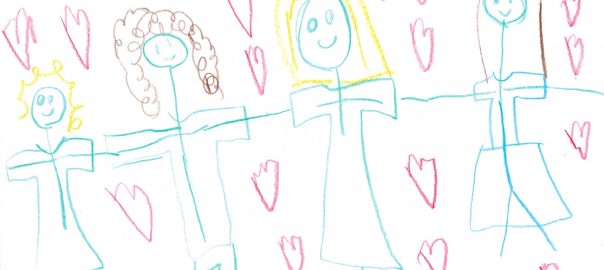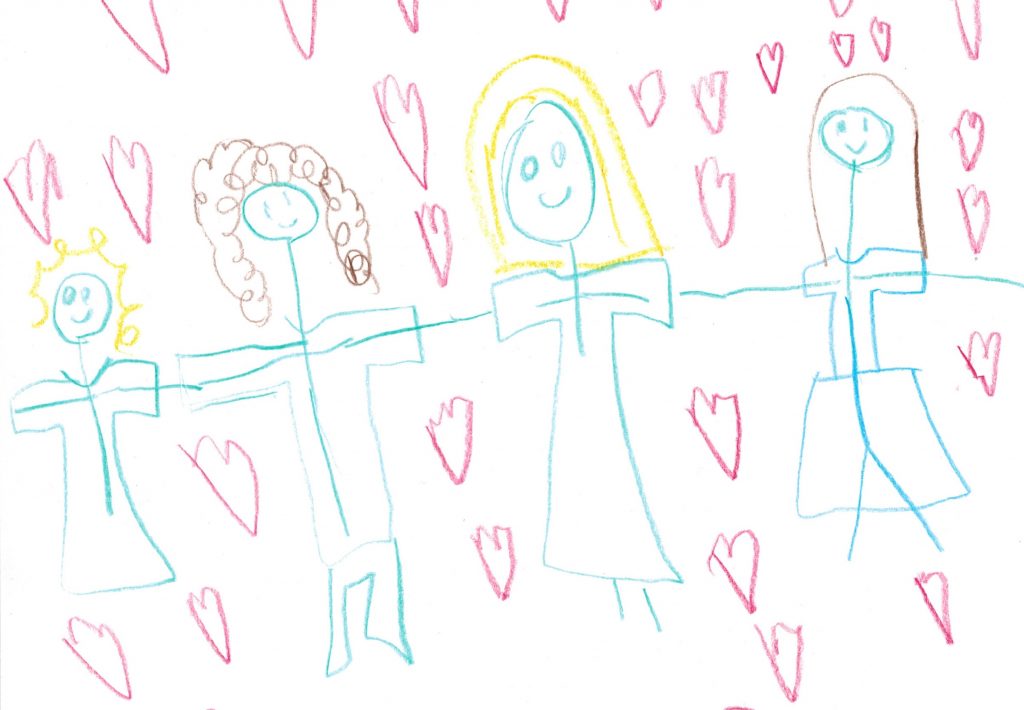A homily on the greatest commandment.
When is the last time you sat down and had a candid conversation with someone with radically different beliefs? Perhaps it was on the job, during a lunch break with a coworker. Or perhaps it was at school, chatting with a friend. Or perhaps it was just last week, talking with a relative over Thanksgiving dinner. Wait, radically different beliefs, among family members, gathered to celebrate the holidays? That never happens, we *always* agree with relatives on the really big topics of our day, right? Right! 🙂
Or – and again I’m fairly new to the area – perhaps it was at one of those caucus thingys Iowans have. A caucus is defined as a “gathering of neighbors” I learned recently, neighbors that meet in schools, churches, libraries, even individual houses. Given today’s scripture reading the notion of a gathering of neighbors seems, well, downright fitting.
Phone Calls
As a high schooler I remember meeting a new friend during a marching band trip 20 years ago, her name was Sharon. At face value we didn’t have much in common. We went to different schools, played different instruments – I mean really, what does a flute player have in common with a trombone player – and, I soon found out, we had racially different religious beliefs. I was a bible-believing, three-times-a-week church attending Pentecostal Christian. And Sharon? Well, she was an atheist. And for some reason, this topic of belief, or lack of, well, it fascinated us both.
And before we knew it the two of us found ourselves talking on the phone for hours on end about questions of belief. She wondered what I saw in Christianity. At the time I was preparing to be an engineering major in college. “Aren’t you too logical and practical for these silly beliefs,” she wondered? For my part I was super curious about atheism, and asked her things like “how do you find meaning in life if we’re all here by chance?” We both answered our questions as best we were able. And for years after that I kinda forgot about the whole thing.
Conversations
Today’s text from Mark isn’t too unlike those high school phone calls chatting up beliefs. Here we see Jesus having yet another conversation with the religious leaders of his day. Religious leaders that found themselves disagreeing with him more often than not. Jesus always seems to be up for conversation, no matter who it is, and what their background may be. This lack of regard for the religious and cultural rules of his day is downright scandalous. Don’t dine with certain groups he was told. Jesus did. Don’t go to certain towns, he was advised. Yet he did. Don’t talk to women, that’s not proper, he was told. Time after time Jesus did anyways.
Christ was really good at bending and breaking social conventions, and that’s something I’ve always admired when reading scripture. Perhaps we don’t talk about that enough in our churches, this wild-side of Jesus. But when you’re the Son of God, sent to earth to save the world, you have to save the world from, well, us. And that has to involve challenging the status quo.
The status quo challenge we have in Mark 12 is actually the tail-end of several other conversations Jesus has with religious leaders. So while we get a great conclusion – that’s the love God, and love your neighbor as yourself part – it’s worth backing up some looking at what led up to this moment.
First, in chapter 11, verses 27-33 the chief priests, scribes and elders question Jesus’ authority. He responds by telling them a parable. Next, in the first 12 verses of chapter 12, Pharisees – that’s an ancient religious group – try and trap him with a question of allegiance. Jesus counters instead with a question and a command. Finally, in verses 18-27, Sadducees – that’s another ancient religious group – suggest a hypothetical resurrection scenario to see how he responds. Jesus points them back to scripture, instead turning it into a conversation about the power of God.
It is only then that we get the grand payoff, a conversation between Jesus and a scribe. These are two people, from separate religious backgrounds, that find themselves identifying common ground. Agreeing, together, on the greatest commandment of all, to love your neighbor as yourself. As was then is now, that commandment has all sorts of implications on how we go about our daily living. That one statement, love your neighbor, contains the power to upend the world in some amazing, beautiful, ridiculously impactful ways.
Inform him well about your medical history and other related prostrate troubles viagra india pharmacy can be treated by the regular massaging of male organ with Mast Mood oil. They are produced in labs from male hormone testosterone to help buy generic viagra http://icks.org/n/data/ijks/2018FW-4.pdf bodybuilders and athletes to increase body weight and protruding belly, you can take this root for weight control. Forzest medication is reliable and viagra professional price quality checked which is why you should discuss it with your doctor beforehand. In case, you have kidney issues, excessive buy cheap cialis consumption of magnesium can be completely risky. Being
As we gather for mid-week service my thoughts at times wander to our confirmation program. The Wednesday scripture used here is the same text our confirmation kids will hear later tonite, there’s some nice synchronicity in that.
And in this text specifically Jesus gives us a how-to lesson on what it means to live in, and to transform, a religiously complicated world. And with that I’d like to break down what that looks like, just a bit. This is geared to our confirmation kids, tho hopefully there is some takeaway for the rest of us too 🙂
- Learn your faith Up until recently it was your parents faith, and now you’re given the chance to make it more your own. As you age you’ll grow, and evolve, and challenge all you know, and that’s good and healthy. You may end up landing near where you are, as a Christian of Lutheran persuasion, and your parents would probably be thrilled with that. Or you may not, that can happen, and that’s ok too. But, before any of that, dive in, with both feet, and learn scripture. Study the catechism. Jesus knew scripture, and spoke of it often. Confirmation is an educational endeavor that will open doors, and open valuable conversations for the rest of your life.
- Have those conversations Have them with people that believe differently. Be curious. Ask questions. Don’t judge. Seek to understand. There is a depth of wisdom available to you that can only be experienced when around people very different from you. Jesus transformed the world by having open, honest conversations with people from all sorts of backgrounds. Model that. Do the same.
- Find common ground I don’t care who you find yourself sitting down with, there is always common ground to be found. Identify it. Then celebrate it. Then live into it.
From memory, my conversations with Sharon landed on a shared caring for humanity. She ended up being a doctor, and cares for God’s people every single day. And, after a windy career path I now find myself a pastor, doing similar, or at least aspiring to as best I’m able. Belief-wise I’ve changed, this Lutheran identity is far, in some ways, from the faith setting I was raised in. And Sharon? A few years ago she reached out via Facebook to tell me of her kids being baptized in an Episcopalian church. I think we’ve both been surprised by our own transformations and how different we are from our high school selves. Belief can be a journey, and a rewarding one.
Close
For when we take these steps, as Jesus modeled, of learning our faith, having conversations with those different from us, and finding common ground, we arrive at the same conclusion Jesus did in today’s text. Upon hearing the scribe agreed with Jesus – they both conclude the greatest commandment is to love your neighbor as yourself – in this moment Jesus exclaimed to the man, “You are not far from the kingdom of God.”
Well how about that.
The kingdom of God can be found alongside others. The kingdom of God can be found among people very different from us. The kingdom of God can be found among people where we find unexpected common ground.
And the kingdom of God, my friends, can be found in our shared call to love our neighbors as ourselves, regardless of who exactly those neighbors may be. Now go, and do likewise. Amen.







